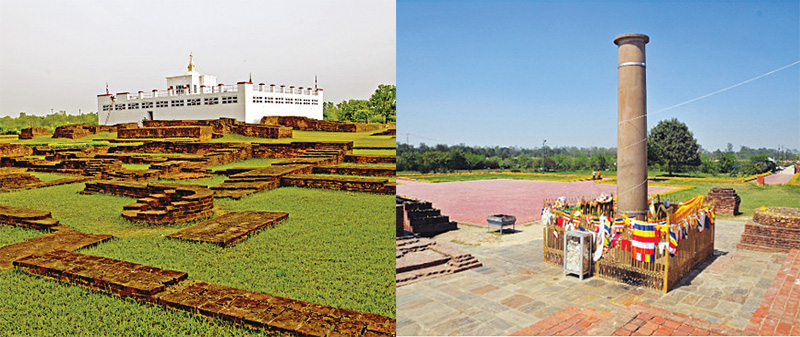Rediscovering Lumbini: Birth place of Prince Siduhath
Source : island
There is no doubt that this title itself will bring bemusement to the denizens of the land of Mahavamsa. An entire nation failing to recall such an important place may seem impossible, but up until the colonial occupiers started probing the past in the 19th century, the historical significance, or the geographical location of Lumbini had been completely erased from the collective memory of India and Nepal.
The history of India is undoubtedly one of the richest in the world, yet it is one of the least recorded ones as well. The chronicles of the surrounding countries have done a better job in capturing the history of this great land than its own esteemed epics, poems, and legends. For example, the Sri Lankan chronicles Deepavamsa and Mahavamsa were crucial in uncovering the origins of Buddhism and the role Emperor Asoka played in spreading it in Asia. As a result of this paucity of endogenous information, when the British started the Asiatic Society in 1784 to further Oriental Research, they were not aware that India was the birthplace of Buddhism. Observing the curly, short hair depicted on statues and carvings being discovered, they assumed that those antiquities belonged to an African cult. For a time, they confused Sri Lankan king Devanam Piya Tissa with the Devanam Piya (Asoka) of India and wondered why a Sri Lankan king would have erected commemorative pillars in India. Even today, despite years of investigations, the origins of the magnificent Bharhut temple remains a mystery.
Over 1.5 million devotees, 60 thousand of them Sri Lankans, visited Lumbini, Nepal in 2019 before the pandemic disrupted travels. However, as late as the early 20th century, there were no proper roads or facilities available for visitors. The visitors had to go on horseback or ride elephants and carry all their supplies with them. The first recorded visit to Lumbini after Parinirvana was by Emperor Asoka in the year 249 BCE. Asokawadana, a 2nd century Sanskrit poem, describes how Emperor Asoka broke down in tears when he was taken to Lumbini and explained what happened there by his spiritual teacher Upagupta. The last recorded visit prior to the 19th century developments was in 1312 by Ripu Malla King of Kathmandu. After that, the place was neglected, forgotten, and remained elusive to the modern world until 1896, hidden among groves of sal trees, only frequented by wild beasts and the few hunters who go after them.
It was Dr. Francis Buchanan, a surgeon turned botanist, charged with statistical surveys of the occupied territories by the governor of Bengal, that learned the connection between India and the founder of the religion of Ava or Inwa, a kingdom of Myanmar, known as Boodh. Based on information he gathered during his visits to Ava and Katmandu, he published a paper in 1797, the first English document describing “Buddhism,” although he did not use this term. During the next hundred years, major advances were made in the fields of Indian history and archeology. Even though epics such as Mahavamsa had textual information, it was these 19th century developments that enabled the construction of a coherent, evidence-based story that connected the localities and peoples referenced in the historical texts to present day places.
Interests of the Asiatic Society were mainly academic; driven by the curiosity of the strange land they conquered. It did not do much for exploration or preservation of Indian archaeological sites. That had to wait until the establishment of the Indian Archaeological Survey in 1862 with Alexander Cunningham, an army engineers, as its head. However, haphazard digging of ancient ruins by cavalier Indologists looking for valuables or building materials continued unabated. From a hindsight, one cannot stop wondering how much more physical evidence for Buddha and his life could have come to light if these sites were left for systematic archaeological explorations later. Unfortunately, the same could be said about burning of the libraries at Alexandria by Romans, Nalanda by Islamic invaders, or Aluvihara temple, where the Tipitaka was written, by the British in 1848.
A landmark development of this time was the deciphering of the Brahmi and Kharosthi alphabets in 1837 by James Prinsep, the Assay Master of the government mint in Benares. This provided access to inscriptions that were found in increasing numbers on pillars, rocks, and other ruins. A wide-ranging collaboration between civil servants stationed in British colonies enabled the reconstruction of the Indian history of the second half of the first millennium BCE, that has escaped from the collective memory of India. The information from Sri Lankan sources came from the reports of Robert Knox (1641-1720), and civil servants George Turnour (1799-1843) and Alexander Johnston (1775-1849) who translated historical documents. Later, they were supplemented by the works of Rhys Davids (1843 1922) and Hugh Nevill (1847-1897). At the same time, the classic poem The Light of Asia by Sir Edwin Arnold (1832-1904), published in 1879, kindled the Western interests on Buddhism with its mystique laden description of Buddha’s life.
However, the crucial information for the geographical locations of historical sites relevant to Buddha’s life came from two Chinese sources: the travelogues of Fa Hian and Huan Tsang. Fa Hian (Faxian, 337-422 CE) spent ten years in India and two years in Sri Lanka from 380 to 413 CE while Huan Tsang (Xuanzang, 602—664 CE) spent sixteen years in India from 627 to 643 CE. Both kept detailed records of their travels, and copied or translated many local texts to be taken back to China. It is incredible that they managed to travel such vast distances, collect that much information, and take them back to China with the limited facilities available at the time. Interestingly, according to some documents, Fa Hian and Buddhagosha had met briefly at sea while traveling to and from Sri Lanka. The Chinese travelogues contained relative positions of the sacred sites they visited: the distances, travel times, and direction of travel to reach them as well as detailed descriptions of the sites.
Bodhgaya was the first to be identified as an important Buddhist landmark, and it was Francis Buchanan who made the connection. While conducting his first statistical survey of the regions West of Calcutta in 1811, Buchana came upon the village of Gaya. He was astonished to see that all structures of the village were constructed of salvaged materials, bricks, and decorated stones of varying sizes. A local Brahmin had confirmed that they came from older constructions found abundantly in the countryside, but of unknown origin. Buchanan also observed that most of the ancient statues, carvings, and decorations were repurposed in the Hindu shrines. A statue of a Hindu deity was found to be a Buddha statue altered with clay and paint. Buchanan identified Bodhgaya as the place that the Chinese travelers described as the place where Siduhath attained enlightenment. The completion of excavation and restoration of the Bodhgaya temple complex was left to the Archaeological survey led by Cunningham after a failed restoration effort by a group sent by the King of Ava in 1879. The role of Mahabodhi society and Anagarika Dhamrmapala in this effort need not be repeated here. Bodhgaya was the first historical place associated with Buddha to be identified by modern Indologists.
After reconstructing the time and life of Emperor Asoka, most of the sites connected with the Buddha’s life were identified, excavated, and restoration works initiated by the year 1890. However, out of the four places most important to Buddhists, Lumbini, the birthplace of Prince Siduhath had not been located. The Indian Archeological Survey was broken-up in 1889, and exploration and preservation were neglected. This gave the local administrators the authority to do what they thought was best, thereby giving the opportunity for anyone to become an armature archeologist.
Two types of people entered the race to find other the remaining undiscovered important sites described in the texts, including Lumbini. First were the government officials who tried to follow the topographical directions provided in the Chinese documents. Two such professionals were Vincent Smith, who rose through the ranks to become District Magistrate and Collector and Dr. Lawrence Waddell, an officer in the Indian Medical Service. The second type were the property owners who could dig anything in their property at will. During one such random dig of a mound, a potsherd and some bone fragments were recovered, but were thrown in the river by the disappointed excavator. The interpretation of the inscriptions found there on a later date revealed that it was Buddha’s alms bowl that was thrown away.
A third type comes into the story of Lumbini in the form of one Dr. Alois Fuhrer (1853-1930). Many documents credit him with the discovery of Lumbini, but there is another, darker side to that story. He was a German Indologist working as a low-level officer for the North-Western province. His “involvement” with the discovery of Lumbini and Piprahwa relics brought him immense publicity and respect. He was adorated so much by Buddhists that one Mahabodhi Society report claimed he would become a Buddhist monk in Sri Lanka. It took a while to come to light that he was a “a forger and dealer in fake antiquities.” The unfortunate association of this shadowy figure cast doubts about the authenticity of several archeological finds of that time. What follows is an account of the lesser-known side of the Lumbini story.
The two professionals, Smith and Waddell worked independently of each other but were guided by the same information provided by Fa Hien, Huan Tsang, and the previous fieldwork by Cunningham. They both concluded that Cunningham’s earlier identifications of Bhuila and Kesia as Kapilavastu and Kusinagara, respectively, were incorrect. The geography of the Gangetic plains had shifted significantly from the time of Fa Hien and Huan Tsang due to annual flooding of the river. Cunningham assumed that Pataliputra must have been swept away leading to this mistaken identity.
After several unsuccessful explorations, Waddell managed to locate Pataliputra, emperor Asoka’s capital, just outside the present-day town of Patna. He was aided by numerous accidental finds of archaeological artefacts surfaced during several construction projects. A cartload of statues was taken away by an overseer and disappeared never to be found on one such occasion. Elaborately carved stonework had been used to build a dam. Confirmation of the location of Pataliputra gave another reference point for siting Lumbini. Based on the cartographic information given by Fa Hian, Huan Tsang, and a Tibetan Pilgrimage Guide, Waddell postulated the locations of Lumbini and Kapilavastu relative to Pataliputra and send a proposal to the government to carry out excavations.
Waddell’s proposal was approved but he was unable to carry out the work as he was assigned other duties. First, he was sent to a war front, and then appointed as the Professor of Chemistry and Pathology at Calcutta Medical College. In Dr. Waddell’s absence, Dr. Alois Fuhrer, the same person who would later come out as a fake, was appointed to carry out this work.








